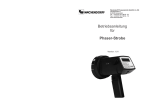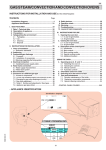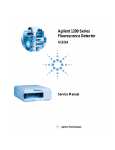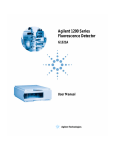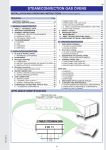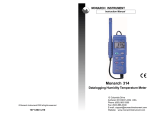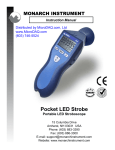Download Monarch 1071-4833-121 Stroller User Manual
Transcript
MONARCH INSTRUMENT Instruction Manual Phaser-Strobe Portable Stroboscopes Printed in the U.S.A. © Monarch Instrument 2002 all rights reserved 1071-4833-121 15 Columbia Drive Amherst, NH 03031-2334 USA Phone: (603) 883-3390 Fax: (603) 886-3300 E-mail: [email protected] Website: www.monarchinstrument.com Safeguards and Precautions 1. Read and follow all instructions in this manual carefully, and retain this manual for future reference. 2. Do not use this instrument in any manner inconsistent with these operating instructions or under any conditions that exceed the environmental specifications stated. 3. Use of this product may induce an epileptic seizure in persons prone to this type of attack. 4. Objects viewed with this product may appear to be stationary when in fact they are moving at high speeds. Always keep a safe distance from moving machinery and do no touch the target. 5. There are lethal voltages present inside this product. Refer to the section on Lamp Replacement before attempting to open this product. 6. Do not allow liquids or metallic objects to enter the ventilation holes on the stroboscope as this may cause permanent damage and void the warranty. 7. Do not allow cables extending from unit to come into contact with rotating machinery, as serious damage to the equipment, or severe personal injury or death may occur as a result. 8. Do not direct strobe flash toward certain data collectors, as it may temporarily interrupt data collector operation, and could result in loss of stored data. 9. This instrument may not be safe for use in certain hazardous environments, and serious personal injury or death could occur as a result of improper use. Please refer to your facility’s safety program for proper precautions. 10. This product contains sealed lead acid batteries which must be disposed of in accordance with Federal, State, & Local Regulations. Do not incinerate. Batteries should be shipped to a reclamation facility for recovery of the metal and plastic components as the proper method of waste management. Contact distributor for appropriate product return procedures. 11. This instrument is not user serviceable. For technical assistance, contact the sales organization from which you purchased the product or Monarch Instrument directly. LIMITED WARRANTY SELLER warrants hardware products to be free from any defect in materials or workmanship for a period of one (1) year from date of shipment to BUYER. SELLER’s entire liability and BUYER’s sole and exclusive remedy resulting from any defect in workmanship or material in the hardware product covered by this limited warranty shall be limited to and fully discharged by the SELLER’s option of replacement or repair of such item without charge. The limited warranty provided in this clause is in lieu of all other warranties, expressed or implied, arising by law or otherwise. ALL IMPLIED WARRANTIES OF MERCHANTABILITY AND FITNESS FOR A PARTICULAR PURPOSE ARE EXCLUDED. This limited warranty shall not be modified except by an arrangement signed by both parties specifically referencing this clause. SELLER warrants that any software supplied will operate in accordance with the documentation or manual supplied therewith in all material respects when used in strict compliance with such documentation or manual. Notwithstanding the foregoing, BUYER acknowledges that, since software is complex and therefore may have defects, BUYER’s sole and exclusive remedy for any such defects or breach of this warranty shall be to require SELLER, within a reasonable period of time, to provide all reasonable programming services to correct programming errors in the software. Except as provided above SELLER MAKES AND BUYER RECEIVES FROM SELLER NO EXPRESS OR IMPLIED WARRANTIES OF ANY KIND WITH RESPECT TO ALL OR ANY PORTION OF SOFTWARE AND BUYER HEREBY AGREES AND ACKNOWLEDGES THAT IT ACCEPTS THE SOFTWARE IN ‘AS IS’ CONDITION. SELLER HEREBY EXPRESSLY EXCLUDES ANY IMPLIED WARRANTIES OF MERCHANTABILITY OR FITNESS FOR A PARTICULAR PURPOSE WITH RESPECT TO THE SOFTWARE. BUYER agrees that any specific right or remedy granted to BUYER hereunder with respect to any breach or default by SELLER shall be in lieu of all other rights and remedies otherwise available to BUYER at law or in equity as the result of such breach or default, regardless of whether based on contract, tort, strict liability, or other theory of liability. IN NO EVENT SHALL SELLER BE LIABLE FOR ANY SPECIAL, INDIRECT, INCIDENTAL, CONSEQUENTIAL, OR PUNITIVE LOSSES OR DAMAGES (INCLUDING, BUT NOT LIMITED TO, LOSSES OR DAMAGES FOR ANY LOST PROFITS OR LOST DATA) AS THE RESULT OF ANY BREACH OR DEFAULT BY SELLER WITH RESPECT TO THE HARDWARE OR SOFTWARE, EVEN IF SELLER HAS BEEN ADVISED OR MADE AWARE OF THE POSSIBILITY OF ANY SUCH LOSSES OR DAMAGES AND REGARDLESS OF WHETHER THE CLAIM IS BASED ON CONTRACT, TORT, STRICT LIABILITY, OR OTHER THEORY OF LIABILITY. This limited warranty does not extend or apply to consumables (including, but not limited to, lamps and batteries, if applicable) or equipment, instruments or accessories which are warranted separately by the original manufacturer of these items. DECLARATION OF CONFORMITY TABLE OF CONTENTS 1.0 INTRODUCTION ..................................................................... 1 As Manufacturer: Monarch Instrument 1.1 Direct Digital Synthesis ...................................................................... 1 Division of Monarch International Inc. 15 Columbia Drive, Amherst NH 03031 USA 1.2 Display Panel ..................................................................................... 1 declares under Monarch’s sole responsibility that the product: Name: Models: NovaStrobe - Stroboscope PB Phaser-Strobe 2.1 Power ................................................................................................ 2 2.2 Input / Output Connections ............................................................... 2 3.0 OPERATION ........................................................................... 3 to which this declaration relates is in conformity with the following standards: EMC: 2.0 PREPARATION FOR USE ...................................................... 2 EN50082-1:1997 EN50082-2:1995 EN55011:1991 Group 1 Class B 3.1 Using the Knob .................................................................................. 3 3.2 Internal Mode - Standard Strobe Operation ....................................... 4 3.3 External Mode - External Input Required ........................................... 4 3.4 External Delay Modes ........................................................................ 5 3.4.1 External Phase Delay .............................................................. 5 3.4.2 External Phase Delay - Auto Operation .................................... 5 3.4.3 External Time Delay ................................................................. 6 4.0 MEMORY ................................................................................ 6 and therefore conforms with the requirements of Council Directive 89/336/EEC relating to electromagnetic compatibility. Curtis-Straus Laboratories performed the testing of this product. (Report No 980555-1) 4.1 Storing Settings ................................................................................. 6 4.2 Recalling Settings .............................................................................. 7 5.0 USING THE STROBOSCOPE TO MEASURE RPM .............. 7 6.0 LIMITATIONS OF REMOTE OPTICAL SENSORS (ROS-5P) 8 7.0 LAMP AND FUSE REPLACEMENT ....................................... 8 11th August 1998 Manufacturer (Amherst, NH) Alan Woolfson, VP Engineering (Authorized Signature) 7.1 Lamp Replacement ........................................................................... 8 7.2 Fuse Replacement ............................................................................ 9 8.0 BATTERY AND POWER SUPPLY SPECIFICS .................... 10 10.0 OPTIONS AND ACCESSORIES 8.1 Displaying Battery Charge Percentage ............................................ 10 C-4040 Set of mating 1/8 inch (3.5mm) male phone plugs for external input / output 8.2 Low Battery Indication ..................................................................... 10 CA-4044-6 8.3 Charging the Batteries ..................................................................... 10 6 foot (1.8M) input / output cable, 1/8 inch (3.5mm) male phone plug to male BNC connector CA-4045-6 8.4 External Power Supply/Charger ....................................................... 10 6 foot (1.8M) input / output cable, 1/8 inch (3.5mm) male phone plug to 1/8 inch (3.5mm) male phone plug for daisy chaining strobes together 8.5 Battery Disposal ............................................................................... 11 CC-7 Latching carrying case for Strobe with provision for accessories PSC-3 AC Power Supply/Charger, 115 VAC - 50/60 Hz; Allows continuous operation from AC mains or charges batteries PSC-4 Same as above except 230 Vac - 50/60 Hz R-5 Standard recharger, 115 Vac - 50/60 Hz (14 hour) R-6 Same as above except 230 Vac - 50/60 Hz L-1903 Digital Stroboscope replacement lamp SPC-1 Splash proof Protective Cover for battery model Stroboscopes ROS-5P Remote Optical Sensor with 8 foot (2.5 m) cable for triggering strobe T-5 Reflective tape. 5 foot (1.5 m) roll, 0.5 inch wide MT-190P Magnetic Sensor/Amplifier with 8 foot (2.5 m) cable for triggering strobe IRS-5P Infrared Sensor for use without reflective target at 0.5 inch (12 mm) gap with 8 foot (2.5 m) cable for triggering strobe RLS-5P Remote Laser Sensor with 8 foot (2.5 m) cable for triggering strobe 9.0 SPECIFICATIONS ................................................................ 12 10.0 OPTIONS AND ACCESSORIES .......................................... 13 13 9.0 SPECIFICATIONS Adjustment Knob all ranges and models Rotory knob with 32 detents per rev. Any value can be changed in decade steps (powers of 10) from 0.0001 per detent to 10,000 per detent (depends on mode selected). Time Base Ultra stable Crystal Oscillator Controlled INTERNAL MODE Flash Range 30.0 - 32,500.0 FPM (Flashes per Minute) 0.5 - 541.67 FPS (Flashes per Second) 1.0 INTRODUCTION The Phaser-Strobe is an extremely sophisticated instrument with many features never before available in a stroboscope, yet remains simple to operate. Select only the features you need. Its internal microprocessor with “Direct Digital Synthesis” enables precise settings and measurement which are unique to the Phaser-Strobe, providing the widest flash range of any stroboscope. The unit can store and recall three full, user programmed settings in non-volatile memory, as well as last used settings so that the unit “remembers” all the settings when the power is turned off. The Auto Step mode enables the user to view high speed moving parts in slow motion, with both the rate and step size user programmable. Update Rate Instantaneous Flash Rate Resolution and Accuracy (setting) 100.00 to 2999.95 FPM (Flashes per Minute) 3000.0 to 32500.0 FPS (Flashes per second) 1.1 Direct Digital Synthesis EXTERNAL MODE Flash Range and Display External flash rates to 0 are acceptable 0.0833 to 541.67 ±0.01% Accuracy - FPS 5.0000 to 9,999.9 ±0.01% Accuracy - FPM 10,000 to 32,500 ±0.01% Accuracy - FPM 33,000 to 200,000 ±0.01% Accuracy - FPM 550.00 to 3,333.3 ±0.01% Accuracy - FPS “Direct Digital Synthesis” is the method by which the Phaser-Strobe’s internal microprocessor generates all the signals required to set internal flash rates, time delays and phase shifts. In analog stroboscopes, these values are adjusted using a single or multiple turn potentiometer (knob), which generally lack sensitivity and tend to drift with time. It is very difficult to set absolute values on analog stroboscopes. The Phaser-Strobe, however, synthesizes all signals digitally, in small, very precise steps, all derived from a stable crystal oscillator. In the internal flash mode, these steps are as small as 0.05 flashes per minute. Thus absolute values may be dialed in very easily and accurately. See section 3.1 Using the Knob for more details. Display only (no flash) Update Rate 0.5 Seconds typical D elay - Degrees * (and display) 0 to 359 ± 0.1 100 to 3499.9 FPM 0 to 355 ± 0.1 3500 to 9999.9 FPM 0 to 350 ± 0.1 10000 to 32000 FPM Delay - Time * 0 to 6500 milliseconds ± 0.0001 seconds Auto Step Mode -Step Size -Step Rate 0.0 - 180° -see note 0.0001 to 6.5 seconds per step Memory Store three full settings in non-volatile memory. Last settings before power down remembered and restored on next power up. Display 6-digit alphanumeric display shows information in English. Battery charge and low battery indication. Individual chevrons for mode display. Light Power - Average Instantaneous (per flash) (auto change over) 10W 150 mJoule Low Flash Rate 50 mJoule High Flash Rate Flash Duration 10 - 30 microseconds typical Input Power Internal Rechargable Batteries. External 7VDC 18W Weight 2 1/2 lbs (1.2 kg) including batteries Options Line Powered Supply / Charger Interface Cables, Remote Optical Sensor. Output Pulse 500υsec 5VDC typical Input Pulse 20υs min, TTL to 24VDC max Sensor Power Supply 6VDC @ 50mA Calibration NIST traceable calibration certificate. (standard) Note * Minimum delay is 50υsec in all delay modes 12 1.2 Display Panel The display panel consists of a backlit display with six alphanumeric digits that indicate modes, flash rates, delays, etc. (see Figure 1). Below the six digits are five small chevrons (!) which indicate the present mode of value displayed, and are described below: AUTO PHASE TIME FPS FPM Indicates Auto mode is active Indicates Phase Delay is on the display Indicates Time Delay is on the display Flashes Per Second (hertz) is on the display Flashes Per Minute is on the display Other icons in the display include the following: ! ----LO BAT On Target Indicator Blinks at input frequency Indicates input frequency Figure 1 Display Panel exceeds the limit of the stroboscope Flashes on display when the battery is getting low. It is on steady when the strobe must be recharged. Below the display are six membrane buttons that control the operation of the Stroboscope. The operation of these buttons is explained within section 3.0 Operation. The red LEDs in the top left corner of the DELAY and EXT buttons and the chevrons above AUTO, PHASE and TIME indicate the operating mode. 1 2.0 PREPARATION FOR USE The Strobe may be hand held or mounted on a tripod or other user supplied bracket using the ¼-20 UNC bushing at the base of the handle. 2.1 Power The Phaser-Strobe has internal rechargeable batteries and may also be powered by an optional external AC power supply. The unit should be charged before use (see section 8.3 Charging the Batteries), or can be run continuously from the AC mains with the optional power supply (PSC-3 or PSC-4, see section 8.4 External Power Supply/Charger). The Phaser-Strobe can operate continuously in excess of 60 minutes at 6000 flashes per minute from fully charged batteries. The strobe has a protection feature that prevents the strobe from operating if the battery voltage is low. This condition is indicated by no flash and the display starts blinking “LO BAT”. At this time the batteries must be recharged. The actual operating time of the stroboscope depends on the flash rate and duty cycle of operation. Slower flash rates increase the operating time. 2.2 Input / Output Connections The Phaser-Strobe has input and output jacks on the left side of the ! ! stroboscope (see Figure 2). These can be used for external triggering ! " Out In or synchronization (daisy chaining two or more strobes). These jacks accept 1/8" (3.5mm) phone plugs (input – stereo, output – mono). Figure 2 Input/ The jacks’ outer connection (barrel) is common and the inner or center Output Jacks connection is the signal (see Figure 3). The input jack also has a middle connection which provides power to an input sensor. The input and output are TTL compatible. Refer to section 10.0 Options and Accessories for interface cables. To power the strobe with the external power supply/charger (PSC-3 or PSC-4): 1. Plug the power supply/charger cable into the recharger socket (located below the display panel behind the handle). 2. Plug the power supply/charger into an AC mains wall outlet. 3. Move the switch on the power supply/charger to “RUN”. The stroboscope may operate in the “CHARGE” setting, but will in fact be drawing power from its internal batteries. An LED (light emitting diode) on the front of the power supply indicates the unit is on. NOTE: If the batteries are depleted, they will need to be charged for about 10 minutes before trying to run the strobe from the power supply/charger. WARNING: Do not leave the power supply/charger plugged into the PhaserStrobe if there is no AC applied to the power supply/charger. 8.5 Battery Disposal Prior to disposing of the Phaser-Strobe, the user must remove the sealed lead acid batteries. To do this, remove the lens, reflector and lamp as detailed in the Lamp Replacement section. This will expose 4 screws that must be removed so the reflector housing can be dismantled. There are four additional screws in the case half opposite the input and output jacks that must be removed. The case halves can now be separated, exposing the batteries. Remove the cables from the batteries and place tape over the battery terminals to prevent them from shorting. The batteries should be sent to a recycling center or returned to the factory. The rest of the parts may now be disposed of. The optional ROS-5P (Remote Optical Sensor), MT-190P (Magnetic), IRS-5P (Infrared), or RLS-5P (Laser) sensors may also be used to trigger the unit. NOTE: When using external sensors that are powered by the Phaser-Strobe, i.e. Remote Optical Sensor (ROS-5P), the sensor must be plugged in before the stroboscope is turned on, or the remote sensor may not be powered up. Common The input jack (" pointing Signal Input (GND) into socket) enables an +6V Out to +6V Out to external signal to trigger Sensor Sensor the strobe. In order to use Common the external signal you Signal Input (GND) have to ensure that the strobe is in the External mode. Press the EXT button until the red LED in the top left of the EXT Figure 3 Input Connector Connection Detail button comes on. The range for triggering is from dc to 542 flashes per second (32,500 flashes per minute). There is typically a 5 µsec delay from trigger input to flash. The trigger source should provide a pulse with a minimum duration of 1 µsec. 2 11 8.0 BATTERY AND POWER SUPPLY SPECIFICS 8.1 Displaying Battery Charge Percentage To view the current battery charge percentage, press the DISPLAY button to cycle the display between FPM, FPS, PHASE, TIME, and the battery charge percentage. The battery charge percentage will display the current battery charge level from 0 to 100% for about 2 seconds and then automatically return to FPM. PHASE and TIME are skipped when not in an External Delay mode. When the strobe is not flashing, the battery charge percentage represents the percentage of usable charge left in the batteries. When the strobe is flashing, the percentage value will be lower. The percentage value will generally decrease with increasing flash rates giving the user an indication of how much quicker the batteries will be discharged at the current flash rate. 8.2 Low Battery Indication When the batteries are low, the display blinks “LO BAT” every half second. The strobe may still be used for a short time. When the battery charge is further depleted, the strobe will stop flashing, display “LO BAT” and then completely shut off. When “LOW BAT” is displayed, the unit needs to be recharged (section 8.3 Charging the Batteries) or powered by the power supply/charger (section 8.4 External Power Supply/Charger). 3.0 OPERATION To turn on the stroboscope, depress and hold the trigger. The trigger may be locked in position using the side locking button. To lock the trigger on, hold the unit in the right hand, depress the trigger as far as it will go, and then use your thumb to press the locking button. You can release the trigger and the trigger will be held in place. To release the trigger lock, simply depress the trigger and then release. 8.3 Charging the Batteries When the strobe is powered up, it will operate in the last mode selected prior to turn off. The Phaser-Strobe is shipped from the factory in the Internal mode. The unit may be recharged at any time. You do not need to wait until the low battery condition is indicated. To display the software revision and then do a display test, press and hold the display button and then depress the trigger to turn on the strobe. CAUTION: Use of power supplies or rechargers other than the one supplied (R-5, R-6, PSC-3 or PSC-4) may damage the stroboscope and void the warranty. There are four operating modes for the Phaser-Strobe. These are Internal, External, External Phase Delay, and External Time Delay. All but the Internal mode require an external input signal. To charge the battery with the standard recharger (R-5 or R-6): 1. Release the trigger so the strobe is off. 2. Plug the recharger cable into the recharger socket (located below the display panel behind the handle). 3. Plug the recharger into an AC mains wall outlet. The recharger will fast charge the batteries for up to 5 hours (typically 3½ - 4 hours). Once the fast charge is completed, the recharger will trickle charge the batteries (as indicated by all the chevrons on the display coming on). To charge the battery with the external power supply/charger (PSC-3 or PSC-4): 1. Release the trigger so the strobe is off. 2. Plug the power supply/charger cable into the recharger socket (located below the display panel behind the handle). 3. Plug the power supply/charger into an AC mains wall outlet. 4. Move the switch on the power supply/charger to “CHARGE”. Charging takes approximately 16 hours. WARNING: The unit may be left on to charge overnight, but the unit should not be left on charge indefinitely (more than 36 hours) as this will damage the lead acid batteries. 8.4 External Power Supply/Charger The external power supply/charger (PSC-3 or PSC-4) can also be used to run the stroboscope continuously from the AC mains. 10 With no external input, the Common Signal Input output jack (! pointing away (GND) from socket) provides a TTL Common Signal Input (GND) compatible pulse from the strobe’s internal oscillator. If an external input is applied, the output pulse mimics the Figure 4 Output Connector Connection Detail input pulse delayed by whatever delay is active. This output pulse may be used to trigger a second stroboscope synchronously to illuminate larger areas. Many strobes can be “daisy chained”. The output jack of the strobe is connected to the input jack of the next strobe causing all the strobes to flash together and be controlled by the first strobe in the chain. In the Internal mode, the knob adjusts the flash rate from 30 to 32,500 Flashes Per Minute (FPM). In the External mode, an external signal pulse is used to trigger the flash and the knob has no effect. In the External Phase Delay mode, the flash is triggered 1 to 359 degrees after each external signal pulse. The knob sets the amount of delay in degrees. In the External Time Delay mode, the flash is triggered 0.0005 to 6.5 seconds after each external signal pulse. The knob sets the amount of delay in seconds. 3.1 Using the Knob Although the knob on the Phaser-Strobe has an analog style, it is actually a digital encoder that is connected directly to the microprocessor. The knob has very definite steps or clicks (32 per revolution) allowing very definite adjustment, and it can be turned continuously. This is equivalent to having a 550-turn potentiometer in an analog unit. Of course you are not expected to turn the knob 550 times to get from the slowest flash rate to the fastest! Each time the knob is turned, the blinking digit is either incremented (clockwise) or decremented (counter-clockwise). There is an automatic roll over to the next digit on the 0 to 9 or 9 to 0 change. It is possible to adjust from the lowest to highest values using a single digit adjustment. By selecting a different blinking digit, the user can select the step size to increment or decrement the flash rate (time delay or phase delay) of 0.05, 0.1, 0.5, 1, 10, 100, 1000 and 10,000 per ‘click’. When adjusting the flash rate, choose an increment value that will quickly get you in the range you want to be, and then select smaller increments to fine tune the value. NOTE: There are maximum and minimum values in each mode beyond which you cannot adjust. In the Internal Flash mode, the maximum flash rate is 32,500 FPM. If you are adjusting the rate in 1000 increments and you reach a value which on the next 3 increment would exceed the maximum, eg 32,000 to 33,000, the display will not increment. Select a lower digit to increment. There are two ways/modes to select a new blinking digit: Knob 1 mode: Push and hold in the knob and turn to select a new digit. The next digit to blink is dependent upon the direction of the knob rotation. Knob 2 mode (factory default): Push and release the knob without turning it. The next digit to the right will be the blinking digit. If the right most digit is blinking when the knob is pressed, the blinking digit will wrap around to the left most digit. If the knob is turned when the knob is pressed in, the existing blinking digit will be incremented or decremented and a new blinking digit will not be selected. 2. any more than is necessary to free the lens. The reflector is held in place by the front lens and will come loose, but is not necessary to remove the reflector. Hold the lamp with a cloth between your forefinger and thumb and rock it back and forth gently while pulling out. Do not attempt to rotate the lamp. The lamp is socketed and will come out easily when pulled. WARNING: Do NOT touch the new lamp with bare fingers. 3. The lamps are polarized and must be put into the socket matching polarity. Using a lint free cloth, match up the red dot on the plug with the red dot on the socket and gently rock the lamp back and forth while pushing it into place (see Figure 6). Make sure the lamp is in straight and centered in the reflector hole. CAUTION: Do NOT allow the reflector to contact the lamp. To change between Knob 1 and Knob 2 modes, press and hold the DISPLAY and x2 buttons together. The display will show Knob 1 or Knob 2 to indicate the new knob mode. Red Dots 3.2 Internal Mode - Standard Strobe Operation In the Internal mode the stroboscope generates it’s own signals and functions like a regular stroboscope. To put the strobe in Internal mode: 1. Press the AUTO button until the AUTO chevron in the display is off. 2. Press the EXT button until the LED in the top left of the EXT button is off. In the Internal mode the flash rate can be adjusted using the black knob on the left of the unit (see section 3.1 Using the Knob). The current flash rate is shown on the display. The flash rate can be doubled or halved instantly by pressing the x2 or ÷2 buttons respectively up to the maximum or minimum allowed. Notches The flash rate can be displayed (and adjusted) in Flashes per Minute or Flashes per Second (FPM or FPS). Press the DISPLAY button to cycle between FPM, FPS, and a display of the battery charge percentage that will automatically return to FPM after about 2 seconds. The chevrons on the display indicate which measurement is currently displayed. The unit automatically computes between FPM and FPMS so you can set the rate in FPM and then view it in FPS by pressing the DISPLAY button. Since you can only delay in the External mode, pressing the DELAY button while in the Internal mode will cause the error message “EXT ->” to be displayed. 3.3 External Mode - External Input Required In the External mode there are no adjustments the user can make. The flash rate is a function of the input signal. This mode is used to synchronize the flash to an external event (from an optical sensor, for example) to stop or freeze motion. The flash will be triggered on the falling edge of the external input pulse. To put the strobe in External mode: 1. Press the AUTO button until the AUTO chevron in the display is off. 2. Press the DELAY button until the LED in the top left of the DELAY button is off. 3. Press the EXT button until the LED in the top left of the EXT button is on. Figure 6 Lamp Replacement 4. Reinstall the reflector and then position the front lens in place matching up the notches on the lens with the two small tabs on the housing to prevent lens rotation (see Figure 6). Push the tabs on the front rim outward and press the lens into place. 7.2 Fuse Replacement There is a 5 x 20 mm fuse inside the unit which may be accessed by removing the lens and reflector (refer to section 7.1 Lamp Replacement). Under normal operating conditions, the fuse should never blow. Examples of abnormal operating conditions would be foreign materials entering the strobe, such as water, ink, etc. If the fuse needs to be replaced, replace only with a fuse of the same type and value: Slow Blow - 3.15A fuse (part# 1062-3004-001). As in the Internal mode, the actual flash rate can be displayed in Flashes per Minute or Flashes per Second (FPM or FPS). Press the DISPLAY button to cycle between FPM, FPS, and a display of the battery charge percentage that will automatically return to FPM after about 2 seconds. The chevrons on the display indicate which measurement is currently displayed. 4 9 For a two-point calculation the actual speed is given by: RPM = AB/(A-B) Pressing the DELAY button will put the unit into one of the two External Delay modes as explained in the next section. RPM = 2XY(X+Y)/(X-Y)2 where X = (A-B) and Y = (B-C) 3.4 External Delay Modes – External Input Required For a three-point calculation: If a Remote Optical Sensor or Magnetic Sensor is used to sense one pulse per revolution (External mode), the readout will display directly in RPM (FPM) without any adjustment required. In instances when you can shut down the device and install a piece of reflective tape, then an optical tachometer is easier to use for RPM measurement. Stroboscopes should only be used when you can’t shut down the device. The human eye is not easily tricked into seeing a stopped image by a stroboscope when the flash rate is slower than 300 FPM. Therefore, stroboscopes should not be used below 300 FPM for inspection or to measure RPM. 6.0 LIMITATIONS OF REMOTE OPTICAL SENSORS (ROS-5P) Remote Optical Sensors (ROS-5P) have a limitation when used with the Phaser-Strobe because they sense not only the reflective marker but the strobe flash as well. If the ROS is positioned near the strobe, the light from the strobe may cause the ROS to trigger the stroboscope at the wrong time, especially when using a delayed flash mode. The Phaser-Strobe has an “Input Blanking” feature to allow it to ignore this false trigger. Even with the Input Blanking, large delays cannot be obtained using an ROS if the strobe’s flash is triggering the ROS. The duration of the ROS pulse in response to the strobe’s flash is about 0.5 milliseconds to 1.1 milliseconds depending on the flash rate. This limits the largest delay possible because the flash swamps the signal from the ROS, and consequently it will not provide the pulse from the reflective marker. If large delays are desired, reposition the ROS so it is away from the strobe’s flash or use a magnetic sensor. The Input Blanking feature itself limits the maximum delay, which is detrimental to non-optical sensors. It is possible to disable (or enable) the blanking in the Phaser-Strobe. To toggle the Input Blanking on or off, press and hold the x2 button and then press the ÷2 button. The display will show “BLANK” when Input Blanking is on and “NO BLK” when it is off. 7.0 LAMP AND FUSE REPLACEMENT 7.1 Lamp Replacement WARNING: Before attempting to remove the lamp, make sure the stroboscope is turned off and any mains cord is removed from the AC outlet. Allow the lamp to cool waiting at least 1 minute. The stroboscope is designed to discharge the internal high voltages within 30 seconds. However, caution should be exercised when replacing the lamp. The lamp can be replaced by using just a pocket screwdriver. It is not necessary to remove any screws to replace the lamp. A new spare lamp is supplied with each new PhaserStrobe Kit. To change the lamp: 1. Push apart the two tabs on the side of the reflector housing and remove the front lens using a small screwdriver to help pry one tab and lift the lens. Take care not to pry the tab 8 Pressing the x2 or ÷2 buttons has no effect on operation. There are two External Delay modes: Phase Delay and Time Delay. In order to activate these modes, the strobe must be in the External mode as indicated in the previous section. To put the strobe in the Phase Delay mode or Time Delay mode: 1. Make sure the strobe is in External mode (see previous section). 2. Press the DELAY button. The display will show PHASE – TIME – OFF sequentially as the DELAY button is pressed. When the display shows PHASE the strobe is in the Phase Delay mode. When the display shows TIME the strobe is in the Time Delay mode. When the display shows OFF the unit is in the External mode as described in section 3.3. The LED in the top left of the DELAY button will be on when the strobe is in the Phase Delay mode or Time Delay mode. The display is extremely versatile in the External Delay modes. The flash rate can be displayed in FPM or FPS, the Phase delay in degrees or the equivalent Time delay in seconds. The internal microprocessor automatically computes between Phase delay and Time delay. Press the DISPLAY button to cycle the display between FPM, FPS, PHASE, TIME, and a display of the battery charge percentage that will automatically return to FPM after about 2 seconds. The chevron below the display indicates which measurement is currently being displayed. 3.4.1 External Phase Delay Mode In the External Phase Delay mode the user can delay the flash from 1 to 359 degrees after a trigger from the external input. This enables the user to vary the stopped motion image at any position (angle) without having to move the trigger source. The user can vary the phase delay in increments as small as 0.1° using the black knob on the left of the strobe. Changing the Phase is done in the same manner as changing the flash rate (refer to section 3.1 Using the Knob.) There are some limitations to the Phase delay at higher flash rates (refer to section 9.0 Specifications). The Phase delay can be doubled or halved instantly by pressing the x2 or ÷2 buttons respectively up to the maximum or minimum allowed. 3.4.2 External Phase Delay Mode – Auto Operation There is a special mode of operation in the External Phase Delay mode called the Auto mode. In this special mode, the user can set a phase step and a rate of increment and have the Stroboscope automatically increase the phase delay at the set rate. This has the effect of causing the object being viewed to appear to rotate in steps, giving a slow motion effect to something that is rotating extremely fast. This effect is unique to the PhaserStrobe and opens new possibilities in the inspection and maintenance fields. The External Phase Delay Auto mode is used to automatically change phase delay in steps periodically to give a slow motion effect. A value stored in step determines the step size in degrees. A value stored in rate determines the length of time between steps. Once these values have been set, use the ON button to turn on the stepping. Using a small phase step (<1 degree) and a small step rate (about 0.0100 seconds), a good slow motion effect can be achieved. To put the strobe in the External Phase Delay Auto mode: 1. Put the strobe in the External Phase Delay mode as explained in section 3.4. 5 2. Press the MEMORY/AUTO button until “AUTO” is displayed. (When in the Auto mode, the ‘AUTO’ chevron is displayed.) When the “AUTO” chevron displayed, the secondary (white) button functions are active. These are STEP, RATE, ON, and OFF. To adjust the step size, press the STEP button. The display will show “STEP” for a second and then show the current step size in degrees (phase delay). The blinking digit is the one affected by turning the knob. Adjust the step size using the knob in the same manner you would adjust the flash rate (see section 3.1 Using the Knob). To adjust the rate in seconds, press the RATE button. The display will show “RATE” for a second and then show the current update rate in seconds. The blinking digit is the one affected by turning the knob. Adjust the step size using the knob in the same manner you would adjust the flash rate (see section 3.1 Using the Knob). To begin the Auto Phase Delay, press the ON (DELAY) button. To stop or freeze the motion at any time, press the OFF (EXT) button. The MEMORY/AUTO button enables you to exit the Auto mode, store the current settings or recall previously stored settings (see section 4.0 Memory). 3.4.3 External Time Delay Mode In the External Time Delay mode the user can delay the flash from 0.0005 to 6.5 seconds after a trigger from the external input. This enables the user to vary the stopped motion image at any point in the cycle without having to move the trigger source. The user can vary the time delay in increments as small as 0.0001 seconds (0.1 milliseconds) using the black knob on the left of the strobe. Changing the delay time is done in the same manner as changing the flash rate (see section 3.1 Using the Knob). The Time delay can be doubled or halved instantly by pressing the x2 or ÷2 buttons respectively up to the maximum or minimum allowed. 4.0 MEMORY - STORING AND RECALLING The Phaser-Strobe can to store and recall up to three complete settings. This is exclusive of a fourth setting that is stored each time the stroboscope is powered down, and automatically restored each time it is powered up. Settings can be stored for comparative purposes or for special testing purposes. Storing and recalling can be done in any of the four modes described in section 3.0 Operation. 4.2 Recalling Settings To recall previously stored settings: 1. Repeatedly press the MEMORY/AUTO button until the display shows “RECALL”. The unit is now ready to recall the settings from one of the three memory locations. 2. The numbers 1, 2 and 3 in the top right corner of the DISPLAY, DELAY and EXT buttons respectively refer to the memory locations available. Press either the 1, 2 or 3 button to recall and restore the previously stored settings. NOTE: When recalling previously stored settings, the Stroboscope may be put into a different mode that requires external inputs. Look at the EXT and DELAY button LEDs and the AUTO chevron on the display to determine which mode the strobe is in. The strobe can be put back in the Internal mode at any time by pressing the EXT button and the LED in the top left of the EXT button will go out. 5.0 USING THE STROBOSCOPE TO MEASURE RPM The primary use for a stroboscope is to stop motion for diagnostic inspection purposes. However, the stroboscope can also be used to measure speed. In order to do this several factors need to be considered. First, the object being measured should be visible for all 360° of rotation (e.g. the end of a shaft). Second, the object should have some unique part on it, like a bolt, keyway or imperfection to use as a reference point. If the object being viewed is perfectly symmetrical, then the user needs to mark the object with a piece of tape or paint in a single location to be used as a reference point. If the rotational speed is within the range of the stroboscope, start at the highest flash rate and adjust the flash rate down. At some point you will stop the motion with only a single image of the object in view. At a flash rate twice the actual speed of the image you will see two images. As you approach the correct speed you may see three, four or more images at harmonics of the actual speed. The first single image you see is the true speed. To confirm the true speed, note the reading and adjust the stroboscope to exactly half this reading, or just press the ÷2 button. You should again see a single image (which may be phase shifted with respect to the first image seen). For example, when viewing a shaft with a single key way you will see one stationary image of the key way at the actual speed and at 1/2, 1/4, etc, of the actual speed. You will see 2 images of the key way at 2 times the actual speed, 3 key ways at 3 times, etc. The FPM equals the shaft’s Revolutions Per Minute (RPM) at the highest flash rate that gives only one stationary image of the keyway. 4.1 Storing Settings To store settings: 1. Repeatedly press the MEMORY/AUTO button until the display shows “STORE”. The unit is now ready to store the settings in one of the three memory locations. 2. The numbers 1, 2 and 3 in the top right corner of the DISPLAY, DELAY and EXT buttons respectively refer to the memory locations available. Press the 1, 2 or 3 button to save the setup for later recall. Saved settings can be recalled at any time, even if the unit is powered down and left for years. 6 Stopped Image 1/4 times 1/2 times Flash Rate (FPM) 875 1750 1 time 3500 2 times 7000 3 times 10500 4 times 14000 Figure 5 Object Rotating at 3500 RPM If the rotational speed is outside the full-scale range of the stroboscope, it can be measured using the method of harmonics and multi-point calculation. Start at the highest flash rate and adjust the flash rate down. Be aware that you will encounter multiple images. Note the flash rate of the first single image you encounter, and call this speed “A”. Continue decreasing the flash rate until you encounter a second single image, and call this speed “B”. Continue decreasing the speed until you reach a third single image, and call this speed “C”. 7











